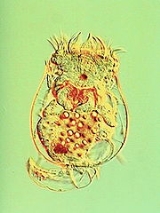
Brachionus
Encyclopedia
Brachionus is a genus
of plankton
ic rotifer
s occurring in freshwater
, alkaline and brackish water
.
,
Brachionus plicatilis
s.s.,
Brachionus ibericus,
Brachionus rotundiformis,
Brachionus manjavacas,
Brachionus sp. Austria,
Brachionus sp. Almenara,
Brachionus sp. Tiscar,
Brachionus urceolaris,
Brachionus sp. Cayman,
Brachionus quadridentatus,
Brachionus dimidiatus,
Brachionus patulus,
Brachionus sp. Nevada,
Brachionus rubens,
Brachionus falcatus,
Brachionus havanaensis,
Brachionus angularis,
Brachionus diversicornis,
Brachionus forficula,
Brachionus dimidiatus,
Brachionus macracanthus,
Brachionus caudatus,
Brachionus bidentata,
Brachionus leydigi
Brachionus spp. are easily reared in large numbers and because of this are used to substitute for wild zooplankton for feeding hatchery reared larval fish. However, the composition of rotifers generally does not satisfy the nutritional requirements of fish larvae, and large amounts of research has been invested in improving the lipid, vitamin and mineral composition of rotifers to better meet the requirements of fish larvae.
). Sexual reproduction is usually induced when population density increases. Transitions to obligate parthenogenesis have been described in Brachionus calyciflorus
. In this species, obligate parthenogenesis can be inherited by a recessive allele, which leads to loss of sexual reproduction in homozygous offspring.
has been demonstrated to be a large cryptic species complex
and it is likely that the number of species present in this genus greatly exceeds those currently described.
Genus
In biology, a genus is a low-level taxonomic rank used in the biological classification of living and fossil organisms, which is an example of definition by genus and differentia...
of plankton
Plankton
Plankton are any drifting organisms that inhabit the pelagic zone of oceans, seas, or bodies of fresh water. That is, plankton are defined by their ecological niche rather than phylogenetic or taxonomic classification...
ic rotifer
Rotifer
The rotifers make up a phylum of microscopic and near-microscopic pseudocoelomate animals. They were first described by Rev. John Harris in 1696, and other forms were described by Anton van Leeuwenhoek in 1703...
s occurring in freshwater
Freshwater
Fresh water is naturally occurring water on the Earth's surface in ice sheets, ice caps, glaciers, bogs, ponds, lakes, rivers and streams, and underground as groundwater in aquifers and underground streams. Fresh water is generally characterized by having low concentrations of dissolved salts and...
, alkaline and brackish water
Brackish water
Brackish water is water that has more salinity than fresh water, but not as much as seawater. It may result from mixing of seawater with fresh water, as in estuaries, or it may occur in brackish fossil aquifers. The word comes from the Middle Dutch root "brak," meaning "salty"...
.
Species
e.g. Brachionus calyciflorusBrachionus calyciflorus
Brachionus calyciflorus is a planktonic rotifer species occurring in freshwater.-Use:* model organism in e.g. aquatic toxicology and evolutionary ecology* hatchery food for larval fish-Reproduction:* Cyclical parthenogenesis...
,
Brachionus plicatilis
Brachionus plicatilis
Brachionus plicatilis is a euryhaline rotifer in the Family Brachionidae, and is possibly the only commercially important rotifer, being raised in the aquaculture industry as food for fish larvae. It has a broad distribution in salt lakes around the world and has become a model system for studies...
s.s.,
Brachionus ibericus,
Brachionus rotundiformis,
Brachionus manjavacas,
Brachionus sp. Austria,
Brachionus sp. Almenara,
Brachionus sp. Tiscar,
Brachionus urceolaris,
Brachionus sp. Cayman,
Brachionus quadridentatus,
Brachionus dimidiatus,
Brachionus patulus,
Brachionus sp. Nevada,
Brachionus rubens,
Brachionus falcatus,
Brachionus havanaensis,
Brachionus angularis,
Brachionus diversicornis,
Brachionus forficula,
Brachionus dimidiatus,
Brachionus macracanthus,
Brachionus caudatus,
Brachionus bidentata,
Brachionus leydigi
Use
Rotifers such as Brachionus calyciflorus are favored test animals in aquatic toxicology because of their sensitivity to most toxicants. They also are used as model organisms in various other biological fields e.g. due to their interesting reproductive mode in evolutionary ecology.Brachionus spp. are easily reared in large numbers and because of this are used to substitute for wild zooplankton for feeding hatchery reared larval fish. However, the composition of rotifers generally does not satisfy the nutritional requirements of fish larvae, and large amounts of research has been invested in improving the lipid, vitamin and mineral composition of rotifers to better meet the requirements of fish larvae.
Reproduction
Brachionus species can normally reproduce asexually and sexually (cyclical parthenogenesisParthenogenesis
Parthenogenesis is a form of asexual reproduction found in females, where growth and development of embryos occur without fertilization by a male...
). Sexual reproduction is usually induced when population density increases. Transitions to obligate parthenogenesis have been described in Brachionus calyciflorus
Brachionus calyciflorus
Brachionus calyciflorus is a planktonic rotifer species occurring in freshwater.-Use:* model organism in e.g. aquatic toxicology and evolutionary ecology* hatchery food for larval fish-Reproduction:* Cyclical parthenogenesis...
. In this species, obligate parthenogenesis can be inherited by a recessive allele, which leads to loss of sexual reproduction in homozygous offspring.
Genome size
Haploid '1C' genome sizes in Brachionus species range at least from 0.056 to 0.416 pg.Genome sequencing
The complete mitochondrial genome of B. plicatilis sensu strictu NH1L has been sequenced.Cryptic species
Brachionus plicatilisBrachionus plicatilis
Brachionus plicatilis is a euryhaline rotifer in the Family Brachionidae, and is possibly the only commercially important rotifer, being raised in the aquaculture industry as food for fish larvae. It has a broad distribution in salt lakes around the world and has become a model system for studies...
has been demonstrated to be a large cryptic species complex
Cryptic species complex
In biology, a cryptic species complex is a group of species which satisfy the biological definition of species—that is, they are reproductively isolated from each other—but whose morphology is very similar ....
and it is likely that the number of species present in this genus greatly exceeds those currently described.

